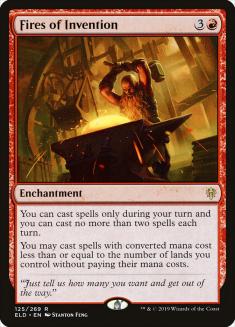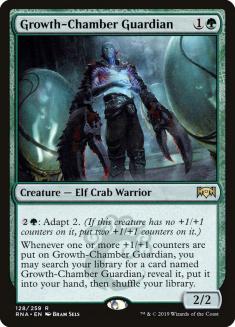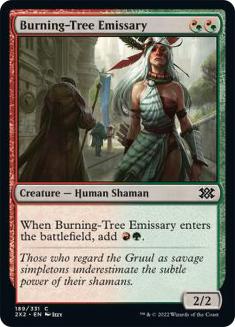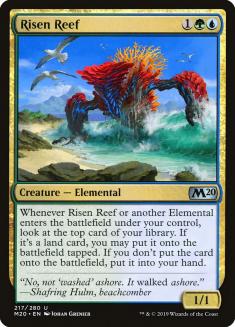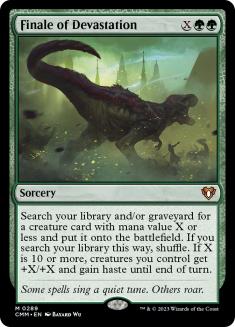Thirteen-year-old me is going bananas over Ashaya, Soul of the Wild.
Ashaya is a truly unique and powerful card, and one that I still haven’t quite wrapped my head around. The five-mana slot in green decks is often contested, as that mana cost needs to be extremely good in order to compete. Five mana is where Nissa, Who Shakes the World lives. Five mana is where Golos, Tireless Pilgrim and Lukka, Coppercoat Outcast sit. Five mana is the sweet spot lately, and now is no different. It just might take some time to figure out the right shell.
First off, Ashaya, Soul of the Wild is big. Really big. However big you might think it is, it’s even bigger than that! In the past, big creatures for a medium amount of mana haven’t been all that important, but sometimes having a big creature in addition to a powerful ability is what makes or breaks a card. For example, Desolation Angel is just a 5/4 flying creature, but having Armageddon attached makes it quite a bit stronger. Uro, Titan of Nature’s Wrath would still be okay if it were just a 3/3, but having such a large body to pressure the opponent or block while drawing a bunch of extra cards and gaining life is a nice bonus.
The money, as always, is going to come from the second ability. Look at that thing. All your creatures are Forests in addition to their other types? That means all your creatures become Llanowar Elves while pumping Ashaya, Soul of the Wild even more than it already is. Let’s say you don’t ramp into Ashaya with anything other than lands. The moment you cast Ashaya, you’re getting at least a 5/5, but then it gets an additional buff from every creature you control and those creatures can tap for mana. The trick is figuring out what type of creature-based deck could utilize that extra mana.
My first inclination said “Selesnya Tokens.” You want a bunch of bodies for Ashaya to get an immediate boost of mana, but you also don’t necessarily want those bodies to already tap for mana. Convoke and Ashaya have similar vibes, as they both give vanilla creatures the ability to give you bursts of mana. Playing Ashaya alongside a bunch of Llanowar Elves doesn’t really make sense because giving your creatures the ability to produce one mana for the second time is irrelevant.
I feel like Magic has put an emphasis on cards that become mana batteries as of late. You just have to jump through hoops to get there. Fires of Invention and Wilderness Reclamation were two major players while they were in Standard because they generated a bunch of extra mana and were virtually free on the turn you cast them. Ashaya, Soul of the Wild is easier to kill, which can invalidate the ability quickly, but not before you tap all your creatures for mana to replace the initial investment. Sound familiar?
We might have to jump through some hoops to play Ashaya, but the payoff is big. Untapping with Ashaya also feels somewhat comical, and likely to be common in formats like Commander. And maybe that’s what it is? Ashaya might be busted in Commander but good enough that it sees play in a number of other formats. I’m just sad it doesn’t work with Kinnan, Bonder Prodigy. The two could have done such great things together.
So what’s the best way to get value out of Ashaya? It doesn’t feel like it belongs in an Elf deck. It also doesn’t feel like it belongs in a Uro deck. You want a lot of creatures but you need to be able to use bursts of mana. The first thing that comes to mind is this:
Growth-Chamber Guardian hasn’t really been “sick” in any deck it goes in. Mostly it saw some play in aggro decks but I’ve never seen it do much there because those archetypes rarely have spare mana lying around. Growth-Chamber Guardian is an early drop that greatly benefits from having extra mana, and that extra mana also makes more bodies that then produce extra mana. Creatures that generate a lot of card advantage when you get a burst of mana, and are also reasonably efficient on their own, seem perfect to pair with Ashaya. While the two won’t be in Standard together due to rotation, it might be worth exploring in Historic.
I know this one isn’t exactly legal in Historic, but I think that might change at some point in the near future. I don’t know why it got suspended exactly, other than being a free Grizzly Bears, but having that free body around in a green midrange deck could be sweet. If we ever get Nykthos, Shrine to Nyx in Historic alongside Burning-Tree Emissary and Ashaya, it’s gonna be game over. While it might not happen anytime soon, this is exactly the type of creature I want alongside Ashaya. When you’re building new decks, it’s important to identify solid pairings of cards, even if we can’t use them together just yet.
A Second Look for Selesnya Tokens
At this point, I just assume everyone wants to see me build a Mono-Green deck every set. I don’t think that’s really my thing, but I don’t mind it that much. What I’m more interested in building right now is a green deck that, wait for it, uses a bunch of tokens! Saproling Migration seems like it could be pretty good with Ashaya, as it makes multiple bodies and has a variable casting cost. What would an actual token deck featuring Ashaya look like?
Creatures (17)
- 2 Emmara, Soul of the Accord
- 4 Venerated Loxodon
- 4 Tithe Taker
- 4 Growth-Chamber Guardian
- 3 Ashaya, Soul of the Wild
Lands (23)
Spells (20)
- 4 Raise the Alarm
- 4 Saproling Migration
- 3 Conclave Tribunal
- 3 March of the Multitudes
- 2 Divine Visitation
- 4 Flower
Sideboard

This token deck has a lot to love, but my main concern is not having enough room for payoffs. March of the Multitudes might make a lot of bodies for Ashaya, but it’s also the payoff for all that mana? Growth-Chamber Guardian is also solid here, but should that really be one of our only payoffs for Ashaya?
The truth is I’m not really sure how to build this archetype. You need a healthy balance of token generators, big-mana payoffs, and ways to defend from your opponent in the early-game. Having those early defensive measures gives you a time buffer to set up your end-game. March of the Multitudes is a heater and can singlehandedly win the game with or without Ashaya, but gaining a ton of creatures to generate a bunch of extra mana to then do as you please has to be the way this thing goes…
Unless there’s something I’m just missing…
Legendary Creature — Elemental
Did you know that Elementals had a huge boost from recent sets to push them into the spotlight? It is unfortunate that most of the good Elementals are going to rotate out of Standard right as we get the perfect Elemental for the strategy, but what’re you gonna do? Maybe Ashaya is just the addition for the Historic version of the archetype!
Risen Reef is a truly remarkable card and an easy build-around. It hits land drops, doesn’t tap for mana, and has a weak body. All of these things make Ashaya a desirable inclusion for Elementals when you’re revolving around Risen Reef. We’ve seen so many different iterations of Elementals over the last year but none of them have really broken through. Maybe Ashaya is the card we need to push it over the top.
Creatures (36)
- 4 Llanowar Elves
- 4 Hydroid Krasis
- 3 Arboreal Grazer
- 4 Risen Reef
- 4 Omnath, Locus of the Roil
- 4 Leafkin Druid
- 4 Cavalier of Thorns
- 4 Uro, Titan of Nature's Wrath
- 2 Nyxbloom Ancient
- 3 Ashaya, Soul of the Wild
Lands (36)
Spells (8)

This version of Elementals plays very fair, but the end-game mana generation with things like Hydroid Krasis is unparalleled. It might take a minute or two to get off the ground, but you’re insulated from removal thanks to most of your creatures drawing an extra card every now and then. One of the coolest things about Risen Reef is that your opponent killing it doesn’t actually hurt that much. You still get the extra card out of it.
The strength of this deck comes mostly when your opponent doesn’t interact with you much, as your goldfish draws feature giant bursts of mana and large monsters. I love this style of deck. Ramping and card advantage are huge deals in Magic right now, and this deck does both quite well. We’re playing Uro, Titan of Nature’s Wrath but we’re not reliant on it, so a ban on that card at some point in the future isn’t too bad for us.
Like the Standard versions, we’re using Arboreal Grazer. Alongside Llanowar Elves, it gives us a much-needed burst of mana in the early turns to get Risen Reef online ASAP. Alongside Cultivate and a healthy land count, we should be fine to hit an extra land most times we draw it. Risen Reef and other card advantage engines in the deck help make sure mid-game Arboreal Grazers aren’t exactly dead cards like in most archetypes that play it.
This is the big mana sink I was looking for. It isn’t exactly busted on its own, but five mana for another copy of Risen Reef is almost always worth it. Plus, you’re not really playing “four copies” when you’re playing 80 cards and Yorion, Sky Nomad. I don’t mind using an early one to generate an extra Llanowar Elves, much like Green Sun’s Zenith in the past. However, as you generate a bunch of mana, there’s literally no better draw in your deck.
I was looking for some way to generate more virtual copies of Risen Reef since we can’t play Eldritch Evolution. Neoform is an option, and something I might try in the future, but I really wanted the jump from three to five mana so I could easily cheat Ashaya onto the battlefield. Neoform is potentially still good, but not quite what we’re looking for right now. Maybe in a different iteration.
The coolest part of Finale of Devastation is the flexibility. As I’ve talked about before in decks like this, variable costs that get bigger and better with more mana, but are still great without a ton, are hugely desirable. My gut says Finale of Devastation is going to be fantastic here, even if I haven’t had much success with it in the past.
Zendikar on the Horizon
The return to Zendikar is bringing a lot of nostalgia with it, including new takes on older cards that perhaps lost or gained a bit of power since the last time we were on this world. Evicting a bunch of Eldrazi from your plane of existence is sure to mix things up. Zendikar was always one of my favorite places in Magic because of the exploration theme. I love looking for hidden gems and Easter eggs. I want nothing more than to play a game of D&D set on this world!
Historic has also become an interesting realm to explore, giving us new tools to pair with our older archetypes that are rotating out of Standard. Seeing these new toys and not being able to pair them with cool Standard stuff is a small bummer, but making Historic into a real format is important. Making cards that will specifically be good in Historic instead of Standard is a very good thing.
I’ll be focusing mostly on Historic when it comes to new cards unless there is a very good reason for me to explore Standard. With all the new cards being added to the format, there’s so much to discover and so many archetypes to try out. I mean, who could say no to Nighthawk Scavenger in the same deck as Pack Rat and Thoughtseize!
Ashaya, Soul of the Wild is a powerful card that could fit into a few existing archetypes or create some entirely new ones. It’s certainly powerful and weird, my favorite combination! These two decks might just be scratching the surface on what it can do, but I’ll be looking for new and interesting ways to build around it once it’s released on Magic Arena.


